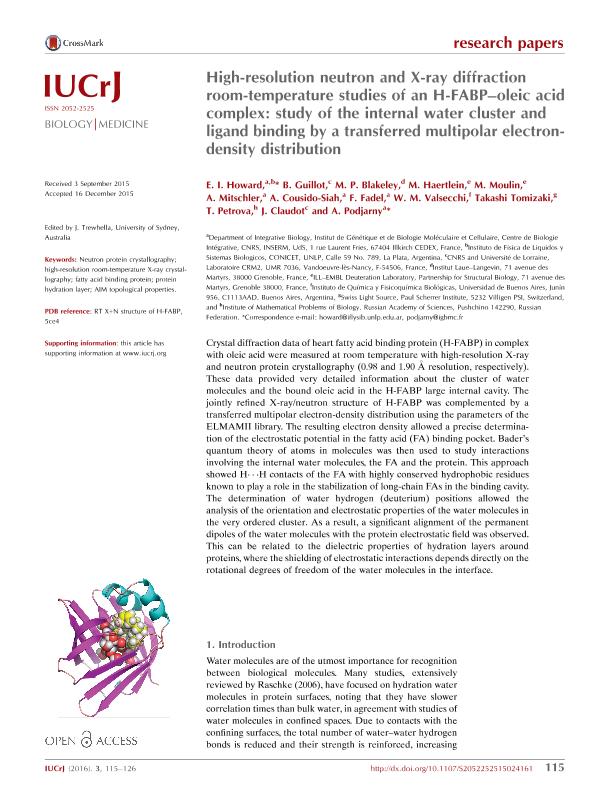Mostrar el registro sencillo del ítem
dc.contributor.author
Howard, Eduardo Ignacio

dc.contributor.author
Guillot, B.
dc.contributor.author
Blakeley, M. P.

dc.contributor.author
Haertlein, M.
dc.contributor.author
Moulin, M.
dc.contributor.author
Mitschler, A.
dc.contributor.author
Cousido Siah, A.
dc.contributor.author
Fadel, F.
dc.contributor.author
Valsecchi, Wanda Mariela

dc.contributor.author
Tomizaki, Takashi

dc.contributor.author
Petrova, T.

dc.contributor.author
Claudot, J.
dc.contributor.author
Podjarny, Alberto Daniel

dc.date.available
2017-06-19T21:40:23Z
dc.date.issued
2016-03
dc.identifier.citation
Howard, Eduardo Ignacio; Guillot, B.; Blakeley, M. P.; Haertlein, M.; Moulin, M.; et al.; High-resolution neutron and X-ray diffraction room-temperature studies of an H-FABP-oleic acid complex: Study of the internal water cluster and ligand binding by a transferred multipolar electron-density distribution; International Union of Crystallography; IUCrJ; 3; part 2; 3-2016; 115-126
dc.identifier.issn
2052-2525
dc.identifier.uri
http://hdl.handle.net/11336/18498
dc.description.abstract
Crystal diffraction data of heart fatty acid binding protein (H-FABP) in complex with oleic acid were measured at room temperature with high-resolution X-ray and neutron protein crystallography (0.98 and 1.90 Å resolution, respectively). These data provided very detailed information about the cluster of water molecules and the bound oleic acid in the H-FABP large internal cavity. The jointly refined X-ray/neutron structure of H-FABP was complemented by a transferred multipolar electron-density distribution using the parameters of the ELMAMII library. The resulting electron density allowed a precise determination of the electrostatic potential in the fatty acid (FA) binding pocket. Bader's quantum theory of atoms in molecules was then used to study interactions involving the internal water molecules, the FA and the protein. This approach showed H···H contacts of the FA with highly conserved hydrophobic residues known to play a role in the stabilization of long-chain FAs in the binding cavity. The determination of water hydrogen (deuterium) positions allowed the analysis of the orientation and electrostatic properties of the water molecules in the very ordered cluster. As a result, a significant alignment of the permanent dipoles of the water molecules with the protein electrostatic field was observed. This can be related to the dielectric properties of hydration layers around proteins, where the shielding of electrostatic interactions depends directly on the rotational degrees of freedom of the water molecules in the interface.
dc.format
application/pdf
dc.language.iso
eng
dc.publisher
International Union of Crystallography
dc.rights
info:eu-repo/semantics/openAccess
dc.rights.uri
https://creativecommons.org/licenses/by/2.5/ar/
dc.subject
AIM TOPOLOGICAL PROPERTIES
dc.subject
FATTY ACID BINDING PROTEIN
dc.subject
HIGH-RESOLUTION ROOM-TEMPERATURE X-RAY CRYSTALLOGRAPHY
dc.subject
NEUTRON PROTEIN CRYSTALLOGRAPHY
dc.subject
PROTEIN HYDRATION LAYER
dc.subject.classification
Otras Ciencias Naturales y Exactas

dc.subject.classification
Otras Ciencias Naturales y Exactas

dc.subject.classification
CIENCIAS NATURALES Y EXACTAS

dc.title
High-resolution neutron and X-ray diffraction room-temperature studies of an H-FABP-oleic acid complex: Study of the internal water cluster and ligand binding by a transferred multipolar electron-density distribution
dc.type
info:eu-repo/semantics/article
dc.type
info:ar-repo/semantics/artículo
dc.type
info:eu-repo/semantics/publishedVersion
dc.date.updated
2017-06-15T17:37:11Z
dc.journal.volume
3
dc.journal.number
part 2
dc.journal.pagination
115-126
dc.journal.pais
Reino Unido

dc.journal.ciudad
Chester
dc.description.fil
Fil: Howard, Eduardo Ignacio. Consejo Nacional de Investigaciones Científicas y Técnicas. Centro Científico Tecnológico Conicet - La Plata. Instituto de Física de Líquidos y Sistemas Biológicos. Universidad Nacional de La Plata. Facultad de Ciencias Exactas. Instituto de Física de Líquidos y Sistemas Biológicos; Argentina. Centre National de la Recherche Scientifique. Igbmc; Francia. Inserm; Francia
dc.description.fil
Fil: Guillot, B.. Centre National de la Recherche Scientifique; Francia
dc.description.fil
Fil: Blakeley, M. P.. Institut Laue Langevin; Francia
dc.description.fil
Fil: Haertlein, M.. Institut Laue Langevin; Francia
dc.description.fil
Fil: Moulin, M.. Institut Laue Langevin; Francia
dc.description.fil
Fil: Mitschler, A.. Centre National de la Recherche Scientifique. Igbmc; Francia. Inserm; Francia
dc.description.fil
Fil: Cousido Siah, A.. Centre National de la Recherche Scientifique. Igbmc; Francia. Inserm; Francia
dc.description.fil
Fil: Fadel, F.. Centre National de la Recherche Scientifique. Igbmc; Francia. Inserm; Francia
dc.description.fil
Fil: Valsecchi, Wanda Mariela. Consejo Nacional de Investigaciones Científicas y Técnicas. Oficina de Coordinación Administrativa Houssay. Instituto de Química y Físico-química Biológicas "prof. Alejandro C. Paladini". Universidad de Buenos Aires. Facultad de Farmacia y Bioquímica. Instituto de Química y Físico-química Biológicas; Argentina
dc.description.fil
Fil: Tomizaki, Takashi. Paul Scherrer Institute; Suiza
dc.description.fil
Fil: Petrova, T.. Russian Academy of Sciences. Institute of Mathematical Problems of Biology ; Rusia
dc.description.fil
Fil: Claudot, J.. Centre National de la Recherche Scientifique; Francia
dc.description.fil
Fil: Podjarny, Alberto Daniel. Centre National de la Recherche Scientifique. Igbmc; Francia. Inserm; Francia
dc.journal.title
IUCrJ
dc.relation.alternativeid
info:eu-repo/semantics/altIdentifier/url/http://journals.iucr.org/m/issues/2016/02/00/tj5008/index.html
dc.relation.alternativeid
info:eu-repo/semantics/altIdentifier/doi/http://dx.doi.org/10.1107/S2052252515024161
dc.relation.alternativeid
info:eu-repo/semantics/altIdentifier/url/https://www.ncbi.nlm.nih.gov/pmc/articles/PMC4775160/
Archivos asociados
